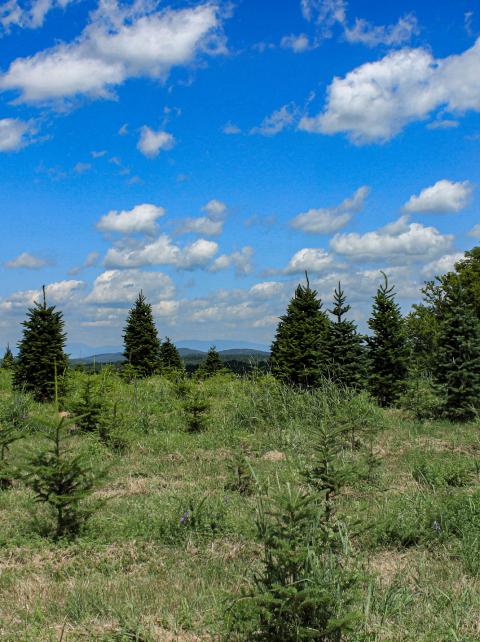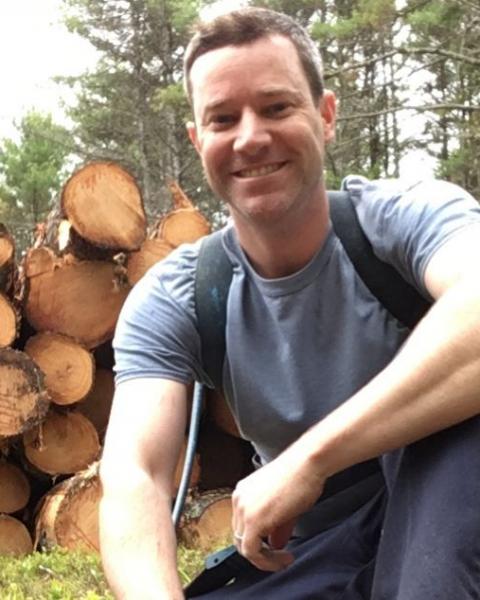The decision to purchase land can be one of the most important financial and personal decisions that you make in your lifetime.
Introduction
The decision to purchase land can be one of the most important financial and personal decisions that you make in your lifetime. Whether you are purchasing land for a woodlot, farm, recreational retreat, or investment, it is important to realize every property is not the same and some may not be able to meet your expectations or satisfy your reasons for purchasing land. One of the most important things you can do is ensure that the property will meet your expectations prior to purchase. To do this there are some important questions that should be considered. Some of these questions apply to any land purchase, while others may be more specific to your goals for the property. To get started, identify why you want to own land and specific features that you want see on the property.
Step One
Clearly Define Your Goals for the Land
Sitting down at the kitchen table with a notebook and pencil and making a list of your ideas can be a worthwhile exercise to help you prioritize your goals. If you are purchasing this land for, or with, your family be sure they have a seat at the table. You may be interested in agriculture. Will that include raising cattle, vegetable farming or growing Christmas trees? If you are interested in recreation, will it be just for your family or a commercial campground? If you want to grow a forest, do you have expectations for return on investment? How would you rank your experience and knowledge level related to your goals for the property? Here are examples of a few reasons for owning land and links to resources to get you started.

These are commonly the most critical considerations for purchasing land, but not inclusive of all purchase considerations. Take a look at UNH Extension’s Landowner Goals and Objectives Form for woodlot owners for some additional examples and ideas that may be of interest if your considering purchasing forested land.
Step Two
Determine What Characteristics are Needed to Meet Your Goals-Based on What You Learned in Step One
Soil and Site Conditions
The foundation of any piece of land is the soil, it is the basis of all productivity. We can tell if the ground is a swamp or a mountain side, but there is a nuanced science of soil characteristics. These characteristics, combined with topography, geographic features and water supply will dictate what land is suitable for, what can grow on it, how productive that growth will be and cost of maintaining selected vegetation.

The Natural Resources Conservation Service and UNH Cooperative Extension can assist you in locating soils information and you can view this information online at WebSoilSurvey and GranitView.
In addition, the presence of wetlands (including prime wetlands) and other hydric soils can impact or influence your plans for your property.
UNH Extension also offers soil testing services to help landowners determine how soil fertility could be improved for growing specific crops.
If you’re considering purchasing waterfront property be sure to familiarize yourself with the Shoreland Water Quality Protection Act.
Forestry and Agricultural Potential
Carefully assess the existing forest and open-land resources on the property. This is one consideration that is often overlooked and can lead to disappointment following a purchase. Here are a couple of examples:
- Landowners interested in growing forest products were unaware of whether the forest was stocked adequately with tree species and quality suitable for their purpose.
- Landowners interested in agriculture were unaware of the high costs of restoring or creating fields and whether the soil is even suited for the desired crops. In addition, access to water can be an issue. For example, if the land has a well, does it go dry during droughts?
In Example 1 (See sidebar), you can request a copy of the forest management plan if one exists. You can also work with a licensed forester for help with understanding the management plan, to obtain a timber appraisal to assess the value of the timber growing on the land, and to assess the potential future timber growth and value. Just as one would hire a licensed home inspector to inspect the a house that is for sale, a licensed professional forester can be hired to assess the quality and value of the forest you are looking to purchase.
In Example 2, you can utilize web soil survey and Granitview to assess the soil’s suitability and topography for agriculture production. You can also work with UNH Extension to better understand what land base is required for the various types of agriculture production. For example, understanding pasture and hayfield management and establishment of new forage stands may be important considerations.
Often projects like orchards and Christmas trees require more work and expense than it appears on the surface. Make sure you are well educated on the process before taking these projects on. UNH Extension regularly coordinates seminars and on-farm twilight meetings which provide an excellent opportunity to gain perspective on the realities of managing such an enterprise.
Example One
Landowners interested in growing forest products were unaware of whether the forest was stocked adequately with tree species and quality suitable for their purpose.
Example Two
Landowners interested in agriculture were unaware of the often-impractical costs of restoring or creating fields and whether the soil is even suited for the desired crops.
Physical location of the land you are buying
Tax maps are often inaccurate. Determine if there is a survey available for the property (New Hampshire County Registries of Deeds) you are looking to purchase and get a copy. Take the time to walk the boundaries. Ask the seller or agent to show you the boundaries and corners. If there are ambiguous references to property lines make sure these are clarified. The buyer typically accepts this risk but should be aware of it. It is important to be aware of any boundary disputes, whether resolved or unresolved. In addition, many sellers and real estate agents do not necessarily know where the boundaries are located. It may require the assistance of a forester or surveyor or other party experienced with reading deeds and locating property lines.
Other Considerations
- Your experience with your future plans for the property.
- Location and proximity to available markets for products that you may produce on the property.
- Nearby businesses producing similar products.
- Size of property to meet productivity goals.
- Production history of property. What was produced on this land in the past?
- Existing condition of property. Will it require significant investments of time, labor or resources to begin utilizing the land?
- If there are no structures on the property, do you want the option of building there in the future? A house? A barn? A cabin?
- Are there restrictions on the land such as a conservation easement or deed restrictions?
- How is the property zoned? Is it enrolled in NH’s Current Use Program?
- Suitable legal and practical access.
- Utilities, including electricity, water sources (for residential and/or agricultural use), cell reception and internet access.


Step 3
Consider Land Use Restrictions
Current Use is a property tax program that private landowners can enroll in to lower their taxes by keeping the land undeveloped.
Zoning Regulations: Property owners in New Hampshire are required to follow Zoning regulations as designated by the Town in which the property is located. Most Towns in NH have Zoning Ordinances which describe the Districts (e.g. residential, rural, commercial) and address permitted uses, setbacks and other limitations on development specific to each district designation. Zoning Ordinances and maps can be found on the Town website usually in association with the Zoning Board information. If you cannot locate the Zoning Ordinances contact the Town Clerk for more information.
Many towns have maps and property records online. Larger cities may manage their own online mapping database and other towns make use of third-party services. Most towns have links to these services on their websites. In many cases, you can also access land records online by searching for the town name and tax maps. These sites will allow you to look up things like property records, tax maps, parcel id, address, owner, zoning district and more. Though there is significant overlap in data on most of these sites, you may have to use more than one to find the town you are looking for. A few towns do not have data on any of these services. Once you find the data you are looking for, you can then review applicable zoning ordinances and contact the Town with questions if you are unsure of whether or not a planned use would be permitted.
Conservation Easements: A conservation easement is a legally binding agreement between a landowner and a qualified organization that usually extinguishes or partially extinguishes development rights and may be prescriptive about how the land is managed in perpetuity. Conservation easements are intended to reduce loss of natural resources values that are targeted by the easement holder. These may include forest resources, wildlife habitat, agricultural soils, scenery, etc. The easement holder has accepted responsibility for maintaining terms of the easement. Easement holders often include state and federal agencies, towns, and non-profit land trusts. Conservation easements are a real property interest and are recorded at the County Registry of Deeds.
If you are considering purchasing a property with a conservation easement on it, obtain a copy of the easement deed and review it carefully, consulting with your legal advisor as necessary. When you are reviewing the easement deed look for terms related to forest management, agricultural practices, soil disturbance, building structures, hunting, commercial
activities and any other activities of interest. In addition, determine what activities require an approval process and what is required of the landowner to gain approval. Make a list of questions and then set up a time to discuss your questions with the easement holder. Depending on the nature of your questions it may be beneficial to meet with the easement holder on site.
Deed Restrictions and Covenants may be written into the fee deed for a property or they may be in a separate recorded document. These restrictions may have been added by a previous landowner, a homeowner’s association, the developer of a subdivision or some other party and are then applicable to all future landowners. They typically list an enforcing party. If the developer of a subdivision added them, they may be enforceable by all subsequent landowners within the subdivision or a homeowner’s association, or perhaps the previous landowner added them and they are enforceable by their successors and assigns. If you have any questions or concerns related to deed restrictions or covenants associated with a property you should consult with your legal advisor to determine the implications of the restrictions and possible impacts to how you would like to use the land. Utility easements, rights of way and Homeowners Associations are other legal instruments or organizations that may impact your use of the land and should be fully researched prior to purchase.
Other Sources of Information:
- GRANITView is the state GIS clearing house and allows you to view statewide spatial data for natural and cultural resources as well as town and parcel boundaries.
- GoogleEarth allows you to view current and past aerial imagery.
- New Hampshire County Registries of Deeds search for deeds and survey plans associated with any property of interest.
- Smart phone mapping apps: There are many great apps available now to help you learn more about a property and its setting in the landscape. Some key words to try in your App Store including: GPS, navigation or mapping.

Learn More
For more information about forestry and land management contact your UNH County Forester. Learn more at nhwoods.org.
This document is provided for informational purposes only and does not constitute legal advice. Ensure that you have knowledgeable and experienced representation in any real estate transaction.




